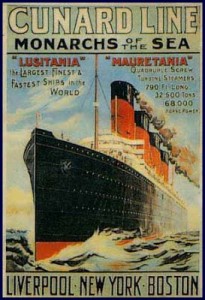 Erik Larson’s Dead Wake: The Last Crossing of the Lusitania will be out soon–March 10–but the reviews (e.g., “…history at its harrowing best”) have me wishing I could get my hands on an advance copy this weekend. If you have one you’re willing to lend, there’s a batch of brownies in it for you…
Erik Larson’s Dead Wake: The Last Crossing of the Lusitania will be out soon–March 10–but the reviews (e.g., “…history at its harrowing best”) have me wishing I could get my hands on an advance copy this weekend. If you have one you’re willing to lend, there’s a batch of brownies in it for you…
Larson consistently proves his gift for avid historical research that lends compelling new insights into milestones like the 1900 Galveston hurricane (Isaac’s Storm). His telling portrayals of individuals’ lives beforehand amplify our comprehension of the aftermath.
The centenary of the sinking of the Lusitania (Hampton Sides calls it “the other Titanic”) has prompted numerous new entries on the subject. Among them, maritime researcher Eric Sauder, noted for expertise regarding passenger ships of the late 19th and early 20th centuries, has two new volumes forthcoming: The Unseen Lusitania: The Ship in Rare Illustrations (May 1) and RMS Lusitania: A History in Picture Postcards (July 1).
Poignant cover art fronting these books depicts Cunard’s proud liner steaming ahead to a fate we know too well. A small, perfunctory item from the Imperial German Embassy published in newspapers days before the ship’s departure had cautioned that “travellers sailing in the war zone…do so at their own risk”. We can’t know how many passengers were ignorant of the warning and how many read and dismissed it. I picture them as relaxed and happy, focused on novelty of the journey and proximity of the destination, caught utterly by surprise when the torpedo streaked toward them from below.
My latest WWI-era (fiction) read, on the other hand, depicts danger from above and residents, not voyagers, who do acutely sense danger. The centerpiece of Esther Freud’s wonderful Mr. Mac and Me is an imagined friendship between famed artist and architect Charles Rennie Mackintosh and teenaged Thomas Maggs, son of a pub owner in a coastal village in Suffolk. (Macintosh actually did sojourn in a similar setting in 1914). Freud also memorably portrays civilians’ experiences in wartime—food shortages, hyper-awareness of outsiders and their motives, upended routines, strange new regulations—and zeppelins.
Both the village lad and the artist are out of their elements. The sensitive, cultured “Mac” would much prefer to be in his beloved Glasgow, but the seaside venue is meant to improve his health and economize on living expenses. Because “Mac” is frequently seen wandering and examining his surroundings (he paints wildflowers), the villagers reckon he’s a spy. Thomas’ own artistic bent, encouraged only by Mackintosh, is ignored by family and discouraged by his teacher. Declaring his fervent wish to work as a sailor on a seagoing vessel, he is reminded that his lameness (no barrier to work around home and pub) would render him useless there.
Through Thomas’ eyes, readers share the terror of Zeppelin raids–or the mere sight of the dirigibles looming above. Running homeward one night, Thomas hears “the roar of thunder through a cloud” and then, “there it is, the round belly of a Zeppelin, directly overhead. The noise fills the whole sky.” Another time, he is awakened by the engine roar; the airship crew ultimately decides not to save all their bombs for London and drops one just down the street.
To combat the distress of these seemingly constant visitations, Thomas imagines what he would invent if he had Count Zeppelin’s financial resources: “A submarine….I picture it streaking to the defence of any ship that is in trouble, scooping the grateful men into its hold.”
If you join a request list for either of these marvelous reads, consider some of the library’s other recent World War I-related acquisitions while you’re waiting:
FICTION
An Unwilling Accomplice by Charles Todd
Hope Rising by Stacy Henrie
The Canal Bridge: a Novel of Ireland, Love, and the First World War by Tom Phelan
After the War is Over by Jennifer Robson
Silence for the Dead by Simone S. James
The Meaning of Names: a Novel by Karen Gettert Shoemaker
NONFICTION
A Higher Form of Killing : Six Weeks in World War I that Forever Changed the Nature of Warfare by Diana Preston
Behind the Lines : WWI’s Little-known Story of German Occupation, Belgian Resistance, and the Band of Yanks who Saved Billions from Starvation … by Jeffrey B. Miller
Ring of Steel : Germany and Austria-Hungary in World War I by Alexander Watson
The Unsubstantial Air : American Fliers in the First World War by Samuel Hynes
World War I : The Definitive Visual Guide : from Sarajevo to Versailles / R.G. Grant, et. al.
A Mad Catastrophe : the Outbreak of World War I and the Collapse of the Habsburg Empire by Geoffrey Wawro


